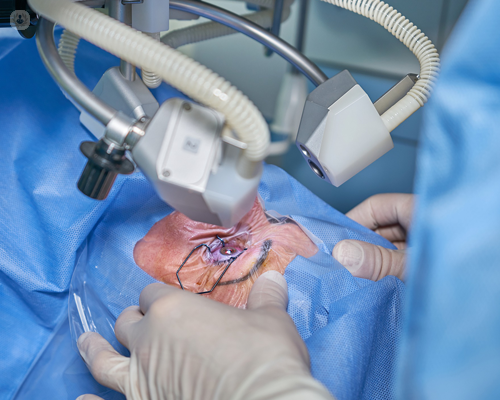Away from the spectacles? The pros and cons of post-cataract surgery
Written by:Internationally-recognised consultant ophthalmic surgeon Mr Sameer Trikha, MBA FRCOphth, looks at the advantages and disadvantages of cataract surgery in this informative article.
The evolution of cataract surgery has been tremendous over the past two decades, and is now one of the safest and effective surgical procedures worldwide. An array of options has now been made available for patients undergoing this procedure due to advances in intraocular lens (IOL) technology. However, there are pros and cons to each option.

What are the different options available for traditional cataract surgery?
Cataract surgery traditionally involved the replacement of the eye’s natural lens with a clear, monofocal (fixed distance) intraocular lens. Patients usually prefer vision that is clear for the ‘distance’, which means they need help with seeing things that are close up by using reading glasses.
A ‘toric’ IOL can be offered in patients with astigmatism (where the eye is shaped like a rugby ball), and this IOL can correct the irregularity. Again, however, this requires the use of glasses for near work.
There is often the benefit of 100 per cent light transmission and excellent contrast sensitivity with these lenses, assuming there is no other eye condition present. Glasses are needed for near work nearly all the time, however, and of course this can be a nuisance.
What are the options for spectacle-free vision post cataract surgery?
There are various IOLs available that can allow for very good near, intermediate and distance vision. This option may be particularly worthwhile for those patients with certain occupations, with a variety of visual needs, or for those who simply don’t enjoy having to wear reading glasses.
However, there is a trade-off with these so-called ‘premium’ IOLs in the sense that; whilst such technology is getting better and better, it doesn’t quite replicate the same quality of vision we had when, for example, we were 21.
In part, this is due to the creation of a lens that has different powers in different segments. This additional functionality in some lens platforms is therefore a trade off at the expense of a small reduction in light transmission and contrast sensitivity. Some patients (around 5-10%) may experience glare, haloes around lights or starbursts in certain light conditions. However, these are usually infrequent and with multifocal lenses, generally most patients feel delighted with the independence from spectacles.
Extended depth-of-focus (EDOF) lenses have also become available in recent years, which allows patients to achieve excellent distance and intermediate vision, across a better range of distances. Generally, these lenses have slightly more light transmission in comparison to multifocal lenses, while near vision may require additional spectacle use for some activities.
It’s important to determine what the best options to suit your particular needs are, considering that there is an array of options available to patients. One option doesn’t meet every patient’s needs.
Please don’t hesitate to contact me at [email protected] to arrange a consultation. I’m always happy to discuss the lens options available following cataract surgery.
If you’d like to book a consultation with Mr Trikha, arrange a consultation with this leading London ophthalmologist today.


